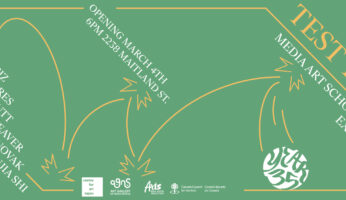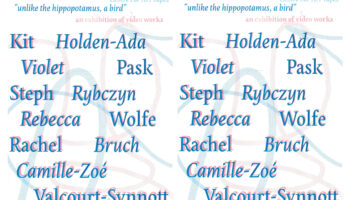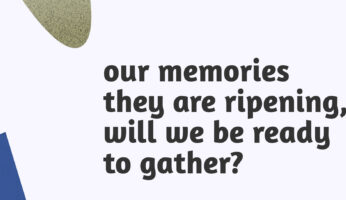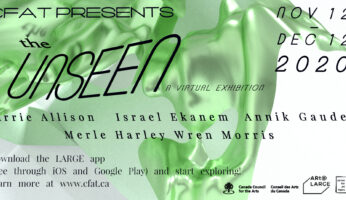33rd Annual Media Art Scholarship Exhibition
March 2nd, 2021 to March 13th, 2021
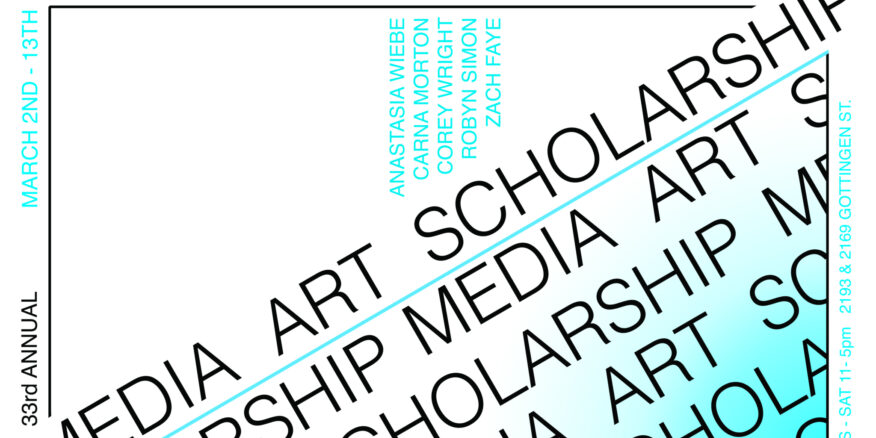
The Centre for Art Tapes is pleased to present the 33rd Annual Media Art Scholarship Presentation. The scholarship is a mentorship program that provides local artists with the chance to explore an aspect of media art with which they have little to no experience. Scholars receive six months of one-to-one guidance from
specially selected mentors as well as workshops taught by experts in areas such as audio/video production and editing, electronics and gallery installation. Scholars receive free access to equipment, facilities and staff support.
Exhibition Locations:
-Window of Alter Egos Cafe (2193 Gottingen St, Halifax)
-Window of Music Nova Scotia (2169 Gottingen St, Halifax)
-Interior of Centre for Art Tapes (can be access through 2169 Gottingen with two sets of stairs, or at main entrance at 2238 Maitland St which is ground level and accessible)
Gallery Hours:
11am to 5pm, Tuesday to Friday
Access Notes:
The installations located at 2193 Gottingen St and 2169 Gottingen St are ground level and can be viewed from the sidewalk. Installations located inside of CFAT can be accessed through our rear entrance at 2169 Gottingen, which has two sets of stairs. CFAT can also be accessed through our main entrance at 2238 Maitland Street, which is ground level and accessible. The door to CFAT does not have a button to press for automatic entry – staff and volunteers will be monitoring the door for anyone who may need assistance.
Safety Notes:
Installations located at 2193 Gottingen and 2169 Gottingen can be viewed from outside. All other installations can only be viewed from inside our facilities at 2238 Maitland Street. We ask that social distancing is maintained while visiting all exhibition locations, and non-medical masks will be mandatory when entering CFAT's facilities. Masks will be provided at the entrance at no cost, along with hand sanitizer. We will be collecting contact information for the purpose of contact tracing, and will be recording our guests' names, contact information and time of visit. As per the current Nova Scotia Public Health Guidelines, we will be keeping this information for 30 days from date of visit for contact tracing purposes.
For more information about the current public health guidelines, visit here: https://novascotia.ca/coron.../restrictions-and-guidance/...
More about this year's program:
This past year, we have all experienced constraints and speed bumps of varying sizes. At CFAT, our flagship Media Art Scholarship program, now in its thirty third year, was not exempt from unpredictable social gathering challenges, Zoom fatigue and struggling to stay grounded in virtual programming. Like many, we had to quickly adapt to remote programming, and while somewhat inevitable, it wasn't always the program we knew it could be.
When it was safe and appropriate, we shifted from Zoom meetings back to in-person programming at our facilities. In this process we have learned the hard way that remote learning (or any combination thereof) sounds okay on paper, but its execution is another matter and many questions remain: What can
artist-run-centres with limited resources do well within this remote framework? Does this new methodology expand on the mandates of our institution or does it constrain them? Most importantly is this fun, engaging and helpful for the participants?
These questions have not been clearly answered but what has become obvious is a strong reassertion of what is invaluable about the Media Art
Scholarship program in the first place. The program has traditionally offered a combination of small group critiques, technical skills-based learning and open studio time for projects to come to fruition. Throughout these six months of building, learning and developing, the scholarship program has always been about concretely fostering relationships and engaging in artistic practices in intimate ways. Importantly, CFAT aims to provide these experiences to any applicant on the merit of their idea and completely forgo traditional selection criteria based on professionalization, experience and credentials.
Understanding how the above mentioned elements solidify the Media Art Scholarship into the program that is known and loved, how do we adapt to the limitations of the pandemic while staying true to our mission of offering accessible and engaging programming? This is still an open question for us at CFAT, and we imagine many other institutions as well. Over this year many educational bodies have professed what they believe to be an effective response to our crisis but the practical experiences of their students and workers seems to contradict many claims. Doubly it's been unfortunate to see the co-option of accessibility discourse to justify a lacklustre implementation of remote learning techniques that are still at their core prohibitively expensive for most people. Non-profits or artist-run-centres such as CFAT are well situated to make more honest assessments of our progress and respond more directly. We do not have the resources of larger institutions but we are also not bound to the profit-incentives and private interests that come with them. We can see our policies work or fail before our eyes in real time.
Our current group of scholars and mentors have partook in this involuntary experiment with us and we thank them for their patience. They have had less
opportunities for face-to-face interactions, peer building, group discussion and limited access to our production resources. Despite these complications they have produced extremely compelling and topical works. Additionally, they have also formulated some practical, creative and effective ideas for exhibiting these works that reflect their level of engagement.
When we reflect on this year's scholars' experience, from good, bad and everything between, we think many answers to the above questions can be found in the work and exhibition itself. Some of the works demonstrate the ways an artist can effectively shift their projects to accommodate current conditions and engage on different levels. Many of the projects speak to isolation and dislocation not just of the year but cultural conditions of colonial capitalism as well. In all of the projects, painstaking dedication, care and commitment to growth are undeniable.
One of the final milestones of the Media Art Scholarship is having the group of scholars democratically decide on a title for their exhibition. This year, when asked what they thought would be a suitable title, the group noticeably froze. Some ideas were hesitantly shared, with some fittingly agreeing on the title "Room Tone," before ultimately choosing to abstain from an exhibition title altogether. Having missed out on some of those invaluable moments of sharing physical space and
connecting in the ways we've all been desperately longing for this year, the scholars couldn't find the language to accurately describe their time together. A familiar experience for us as well. With that, CFAT presents to you the 33rd Media Art Scholarship program.


